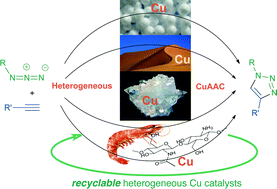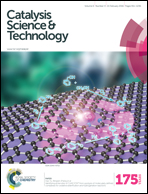When CuAAC 'Click Chemistry' goes heterogeneous
Abstract
Within the green chemistry context, heterogeneous catalysis applied to organic synthesis is becoming an increasingly important field, bringing its own innovation and specific properties to organic chemistry. The well known 'click chemistry' is now challenged by this paradigm change and numerous methods involving heterogeneously catalyzed click chemistry have been and are currently being developed. This review covers these developments and shows that various reliable heterogeneous methods, alternative to the commonly used Meldal–Sharpless method, do exist for click chemistry, including those involving flow chemistry, and that they could be applied to a variety of compounds, solving some problems faced by more conventional methods.

- This article is part of the themed collections: Bioorthogonal and click chemistry: Celebrating the 2022 Nobel Prize in Chemistry and 2016 most accessed Catalysis Science and Technology articles

 Please wait while we load your content...
Please wait while we load your content...